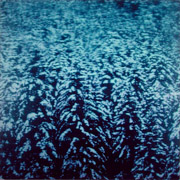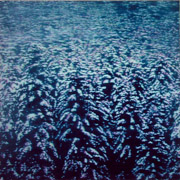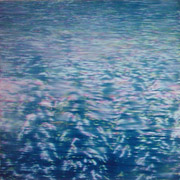


Spring Snow 1, 2 & 3
1996, oil on canvas, each 90 x 90cm
Snow
In the winter of 1995/96 I travelled to the Auvergne region in France to visit my dad Bill and his wife Catherine. One morning I awoke to find that it had snowed on the pine forest overnight. I took numerous slide photographs of the astonishingly beautiful scene, and after processing back in London, was intrigued by how these images looked in miniature. They reminded me of pictures of 'snow' on a TV screen. In their painting, using a dragging technique, I was excited by the effect of a frozen video frame rather than a still photograph that emerged by accident - a more transient and fleeting kind of picture, in contrast to the monumental nature of the subject matter. This discovery fed into the development of much of my subsequent work.
Colorado Snow Effects
A black and white photograph of a snowy landscape, so long as the sky is overcast, works almost as effectively as a colour photograph in representing an almost monochromatic scene. In the Colorado Snow Effect paintings snow scenes are depicted with daubed pixels of pure saturated colour. From a distance these points of colour optically merge and form a greyscale image, revealing the subtle tones required to appreciate the forms of pine trees or line of a hillside. As the painting is approached, colour vision takes over from perceiving gradations of tone, and the impression is one of abstracted coloured noise.
The paintings play with ideas of the white noise or ‘snow’ on analogue television, presenting a dialogue between a surface of background radiation and ideas about landscape as background. Homage is paid to the use of additive colour by the impressionists and the vision-theory inspired work of pointillist divisionism. Yet, whereas the intentions of these movements was to emulate the immediacy of atmospheric scintillation, representing a ‘natural’ impression of a scene bathed in light, the use of pure colour to represent a grey landscape seems like a ridiculous optical overindulgence – although one akin, on a macro-scale, to the three colour channels of a TV monitor. The metaphorical connections between snow, whiteness, silence and purity, and the icy, crystalline matrix of the screen, are subverted through the pathos of exuberant, noisy, tangible colour.
Also see related lenticular experiments: Colorado Snow Drifts